Histone Deacetylase Inhibitors Synergize with Catalytic Inhibitors of EZH2 to Exhibit Antitumor Activity in Small Cell Carcinoma of the Ovary, Hypercalcemic Type
- PMID: 30232145
- PMCID: PMC6279577
- DOI: 10.1158/1535-7163.MCT-18-0348
Histone Deacetylase Inhibitors Synergize with Catalytic Inhibitors of EZH2 to Exhibit Antitumor Activity in Small Cell Carcinoma of the Ovary, Hypercalcemic Type
Abstract
Small cell carcinoma of the ovary, hypercalcemic type (SCCOHT) is a rare but extremely lethal malignancy that mainly impacts young women. SCCOHT is characterized by a diploid genome with loss of SMARCA4 and lack of SMARCA2 expression, two mutually exclusive ATPases of the SWI/SNF chromatin-remodeling complex. We and others have identified the histone methyltransferase EZH2 as a promising therapeutic target for SCCOHT, suggesting that SCCOHT cells depend on the alternation of epigenetic pathways for survival. In this study, we found that SCCOHT cells were more sensitive to pan-HDAC inhibitors compared with other ovarian cancer lines or immortalized cell lines tested. Pan-HDAC inhibitors, such as quisinostat, reversed the expression of a group of proteins that were deregulated in SCCOHT cells due to SMARCA4 loss, leading to growth arrest, apoptosis, and differentiation in vitro and suppressed tumor growth of xenografted tumors of SCCOHT cells. Moreover, combined treatment of HDAC inhibitors and EZH2 inhibitors at sublethal doses synergistically induced histone H3K27 acetylation and target gene expression, leading to rapid induction of apoptosis and growth suppression of SCCOHT cells and xenografted tumors. Therefore, our preclinical study highlighted the therapeutic potential of combined treatment of HDAC inhibitors with EZH2 catalytic inhibitors to treat SCCOHT.
©2018 American Association for Cancer Research.
Conflict of interest statement
Figures
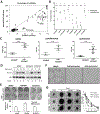
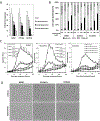
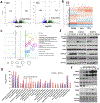
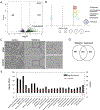
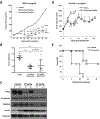
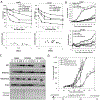
Similar articles
-
Selective Killing of SMARCA2- and SMARCA4-deficient Small Cell Carcinoma of the Ovary, Hypercalcemic Type Cells by Inhibition of EZH2: In Vitro and In Vivo Preclinical Models.Mol Cancer Ther. 2017 May;16(5):850-860. doi: 10.1158/1535-7163.MCT-16-0678. Epub 2017 Mar 14. Mol Cancer Ther. 2017. PMID: 28292935
-
The histone methyltransferase EZH2 is a therapeutic target in small cell carcinoma of the ovary, hypercalcaemic type.J Pathol. 2017 Jul;242(3):371-383. doi: 10.1002/path.4912. Epub 2017 Jun 2. J Pathol. 2017. PMID: 28444909 Free PMC article.
-
Dual loss of the SWI/SNF complex ATPases SMARCA4/BRG1 and SMARCA2/BRM is highly sensitive and specific for small cell carcinoma of the ovary, hypercalcaemic type.J Pathol. 2016 Feb;238(3):389-400. doi: 10.1002/path.4633. Epub 2015 Dec 21. J Pathol. 2016. PMID: 26356327 Free PMC article.
-
Small-Cell Carcinoma of the Ovary of Hypercalcemic Type (Malignant Rhabdoid Tumor of the Ovary): A Review with Recent Developments on Pathogenesis.Surg Pathol Clin. 2016 Jun;9(2):215-26. doi: 10.1016/j.path.2016.01.005. Epub 2016 Apr 12. Surg Pathol Clin. 2016. PMID: 27241105 Review.
-
Small-Cell Carcinoma of the Ovary, Hypercalcemic Type-Genetics, New Treatment Targets, and Current Management Guidelines.Clin Cancer Res. 2020 Aug 1;26(15):3908-3917. doi: 10.1158/1078-0432.CCR-19-3797. Epub 2020 Mar 10. Clin Cancer Res. 2020. PMID: 32156746 Free PMC article. Review.
Cited by
-
Rare Hereditary Gynecological Cancer Syndromes.Int J Mol Sci. 2022 Jan 29;23(3):1563. doi: 10.3390/ijms23031563. Int J Mol Sci. 2022. PMID: 35163487 Free PMC article. Review.
-
Small cell carcinoma of the ovary, hypercalcemic type (SCCOHT): a challenge for clinicopathological diagnosis.Int J Clin Exp Pathol. 2019 Jun 1;12(6):2166-2172. eCollection 2019. Int J Clin Exp Pathol. 2019. PMID: 31934039 Free PMC article.
-
Design of First-in-Class Dual EZH2/HDAC Inhibitor: Biochemical Activity and Biological Evaluation in Cancer Cells.ACS Med Chem Lett. 2020 Mar 19;11(5):977-983. doi: 10.1021/acsmedchemlett.0c00014. eCollection 2020 May 14. ACS Med Chem Lett. 2020. PMID: 32435414 Free PMC article.
-
SWI/SNF Complex Mutations in Gynecologic Cancers: Molecular Mechanisms and Models.Annu Rev Pathol. 2020 Jan 24;15:467-492. doi: 10.1146/annurev-pathmechdis-012418-012917. Annu Rev Pathol. 2020. PMID: 31977292 Free PMC article. Review.
-
Germline SMARCA4 Deletion as a Driver of Uterine Cancer: An Atypical Presentation.JCO Precis Oncol. 2022 Oct;6:e2200349. doi: 10.1200/PO.22.00349. JCO Precis Oncol. 2022. PMID: 36265117 Free PMC article. No abstract available.
References
-
- Martinez-Borges AR, Petty JK, Hurt G, Stribling JT, Press JZ, Castellino SM. Familial small cell carcinoma of the ovary. Pediatr Blood Cancer 2009;53(7):1334–6 doi 10.1002/pbc.22184. - DOI - PubMed
-
- Florell SR, Bruggers CS, Matlak M, Young RH, Lowichik A. Ovarian small cell carcinoma of the hypercalcemic type in a 14 month old: the youngest reported case. Med Pediatr Oncol 1999;32(4):304–7. - PubMed
-
- Estel R, Hackethal A, Kalder M, Munstedt K. Small cell carcinoma of the ovary of the hypercalcaemic type: an analysis of clinical and prognostic aspects of a rare disease on the basis of cases published in the literature. Arch Gynecol Obstet 2011;284(5):1277–82 doi 10.1007/s00404-011-1846-5. - DOI - PubMed
-
- Young RH, Oliva E, Scully RE. Small cell carcinoma of the ovary, hypercalcemic type. A clinicopathological analysis of 150 cases. Am J Surg Pathol 1994;18(11):1102–16. - PubMed
Publication types
MeSH terms
Substances
Grants and funding
LinkOut - more resources
Full Text Sources
Other Literature Sources
Medical
Miscellaneous

